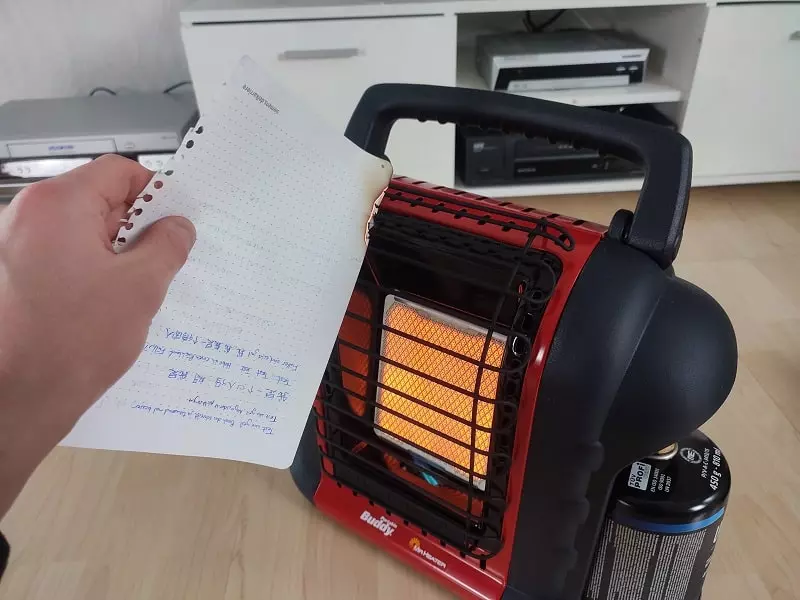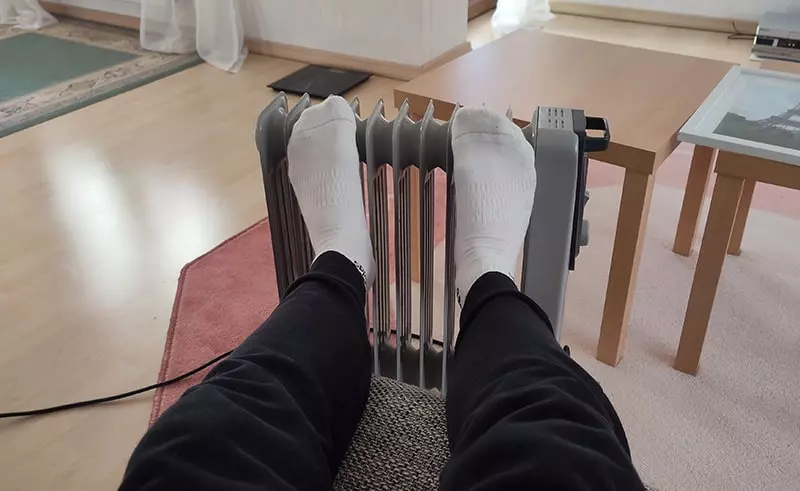What are the best space heaters that are not hot to touch? When you have children or pets around, space heaters that are hot to the touch are not an option.
In this article, you’re going to learn about space heaters with the lowest possible surface temperature.
Quick answer: The Dyson Hot + Cool is the best space heater that’s not hot to the touch. The combination of an embedded heating element and a built-in fan that blows heat out of the heater’s body prevents surface overheating. A more cost-effective alternative is a DeLonghi oil-filled radiator, which maximizes its surface area using thermal slots , and, therefore, minimizes the chance of burning your fingers.
Before we begin a deep dive, to save you some time, let’s check out the winner of the heatertips.com “Not hot to touch”-award.
Recommended Heater: Lowest surface temperature (Dyson)
The heater with the lowest overall surface temperature, and, therefore, safest to touch is this Dyson Hot + Cool (click here to view it on amazon).
Generally, I am very critical of Dyson heaters. They are highly overpriced, they can be noisy(depending on the fan settings), and some of Dyson’s advertising claims are factually wrong.
However, Dyson heaters exceed in safety, especially when it comes to their surface temperature.
The one thing that separates a Dyson Hot + Cool from other space heaters is the strong built-in fan in combination with the hidden heating element.
Due to the hidden heating element inside the case, children and pets can’t access the hot parts of the heater.
And due to the built-in fan, the surface temperature of the heater can’t build up and does not get hotto touch at all.
Technically, Dyson heaters are the coolest-to-touch space heaters.
But since they are so pricey, let me recommend you a much more cost-effective option.
Cost-effective alternative (DeLonghi)
Much more cost-effective than the Dyson Hot + Cool is this DeLonghi TRD40615EBK oil-filled radiator(click here to view it on amazon).
It has a maximum surface temperature of 158°F (70°C), which is less than that of other space heaters with the same power output, but more than that of the Dyson.
For comparison, one of my infrared heaters has a surface temperature of around 350°F (178°C), which is a lot hotter to touch.
Oil-filled radiators generally have a large metal heating body. The larger the surface area, the colder to the touch a heater is (while still delivering the same overall amount of heat).
This DeLonghi oil-filled radiator has a clever thermal slots design, which
- prevents direct touch of the metal heat source and
- increases the total surface area of the heating body
With 1,500W the DeLonghi oil-filled radiator delivers enough heat to keep even larger living rooms at a comfortable temperature during the winter.
Which space heaters are the safest to touch?
There are many different types of space heaters, including oil-filled radiators, infrared heaters, ceramic heaters, propane heaters in many more.
Instead of listing every possible heater and telling you why this specific type is too hot to touch, let me conceptualize something for you.
What makes a space heater (not) hot to the touch?
Most electric space heaters consume 1,500W. According to the laws of thermodynamics, all this electric power eventually ends up as heat.
So, when you’re just looking at the heat output, it does not matter at all whether you use one space heater or the other.
However, when you look for the space heater that’s the safest to touch, in physical terms, you’re looking for low surface temperature heaters.
Now, you can group all space heaters into two categories:
- Space heaters with exposed heating elements
- Space heaters with hidden heating elements
All space heaters with exposed heating elements have surface temperatures hot enough to ignite things. This group includes infrared heaters and propane heaters.
On the other hand:
All space heaters with hidden heating elements are not hot to touch because the heat is distributed over the entire space heater’s surface or through a stream of air, which carries the heat away from the heater.
Heaters with hidden elements are, for example, oil-filled radiators. The heating element of an oil-filled radiator sits inside the large metal case, which, in turn, distributes the heat.
Another example of heaters with hidden heating elements are some heaters with built-in fans, which rely on blowing the air out.
The most prominent examples of those heaters are Dyson Hot + Cool fans. Since they have both a hidden heating element and they blow out air, the heat never accumulates.
In oil-filled radiators, heat accumulates, but to a tolerable point.
Surface temperatures of different space heaters
Using a laser thermometer, I measured the surface temperatures of different space heaters.
| Space Heater type | Surface Temperature in °F and °C |
|---|---|
| Oil-filled radiator | 158°F (70°C) |
| Infrared heater | 350°F (177°C) |
| Propane heater | 850°F (454°C) |
As you can see, the surface temperature grows exponentially with the heating element exposure level.
The heating element in an oil-filled radiator is inaccessible. Before the heat reaches your room, it distributes over the large metal surface.
Infrared heaters have exposed heating elements. These get very hot.
And propane heaters have heating elements that are powered through an open gas flame.
The heating element exposure level determines the surface temperature of a space heater.
 Propane heaters get hot enough to burn paper! This can’t happen with a Dyson Hot + Cool or with an oil-filled radiator.
Propane heaters get hot enough to burn paper! This can’t happen with a Dyson Hot + Cool or with an oil-filled radiator.
Do you really need the coldest-to-touch space heater?
Before you buy your heater, let’s just consider one question: Do you really need the absolute coldest-to-touch space heater?
In most cases, you don’t have to buy the absolute best heater (the Dyson). You can just as well get the DeLonghi oil-filled radiator, and save some money for yourself.
Or, actually, you might even be able to get any heater and might not even need the cool-to-the-touch aspect at all.
So, let’s look at a few situations.
Kids and pets
If you have small kids and pets around, you don’t want them to burn their sensitive fingers (or paws) on the heater.
That’s totally understandable.
Evolution luckily did most of the work already and embedded an understanding of the concept of heat in our genes.
So, kids and pets know what heat is.
They just have to learn that a new object in their living space is hot. So, if you buy a space heater, expect your kid or pet to touch the heater once.
But when it’s hot it will learn quickly to keep some space.
Kids and pets don’t go nuts and burn themselves on purpose. So, you should not worry about that.
In the end, many households use fireplaces or wood stoves, even with small kids or pets around. It’s not a problem. Kids and pets learn and adapt.
So, buying a not-hot-to-touch space heater is more for you. It’s to free your mind of worry. In the end, if something happens, you want to tell yourself that you at least bought the safest heater. And that’s OK.
But don’t underestimate your kids and pets!
Fire hazard worries
It’s totally understandable if you worry about fire hazards caused by space heaters.
However, in this case, getting the space heater with the lowest surface temperature is not always the right solution.
Most space heater fires are caused by cable meltdown when a heater draws more power than your home’s electric circuit can handle.
This has nothing to do with surface temperature. Even the safest space heaters draw enough current to cause an electric failure.
Of course, a low surface temperature reduces the risk of fire. But so does the number of safety features and, before all, the way you use your heater.
If you deliberately look for a safe space heater, then, by definition, you are already the kind of person that takes care of their home safety.
So, the chance of your heater causing a fire is very small.
The heaters recommended in this article are among the safest you can find. In combination with your safety attitude, and proper, careful usage, there is no need to worry at all.
Which not-hot-to-the-touch heaters you should never pick
If you look for a cool-to-touch space heater, then your best bet is always a heater with an embedded heating element and a built-in fan that blows the heat out.
However, that’s optimizing in the wrong direction!
It’s like choosing a car for its great seat belt. But if the car itself has defective airbags and a chassis that crumbles upon impact, you didn’t do yourself a favor.
You get the point.
A low surface temperature that is not hot to the touch is one aspect of a safe space heater.
But:
A low surface temperature that’s not hot to the touch doesn’t make a space heater safe if it does not also come with tip-over protection, overheat protection, and fireproof case material.
One space heater I have at home actually has the lowest of all my different space heater’s surface temperatures.
Interestingly, it’s also the trashiest of all my heaters. If I run it continuously, it’s just a matter of time before it catches fire.
It has a poor-quality plastic case and no safety features at all.
The low surface temperature comes only from the hidden heating element in combination with its built-in fan.
So, never pick a space heater for it’s cool to the touch surface only. It might still be a bad heater.
Instead, get a heater that has a low surface temperature, in combination with fireproof case material and all the safety features.
Both the Dyson and the DeLonghi heater recommended at the beginning of this article fulfill all the criteria of a safe, quality heater!
You can’t go wrong with them.
Conclusion
Space heaters that are not hot to the touch are a great choice to reduce your own worries.
When you are concerned about your kids or pets at home, or about fire-hazard, then a cool-to-touch space heater provides the impression of safety.
So, let me sum up this article with two key learnings:
- Kids and pets are capable of learning which things to touch and which to avoid. Yes, they might burn their fingers on the heater. But this will happen only once. _
_ So, theoretically, you don’t need to buy an extra safe space heater. But I don’t know your exact situation. You decide! - Even space heaters with low surface temperatures consume high amounts of electric power.
Electric power issues in combination with leaving a space heater unattended are the number 1 causes of space heater incidents.
So, you don’t eliminate risks with a low-surface-temperature heater. You eliminate the risk of a fire by never running your space heater in your absence!
